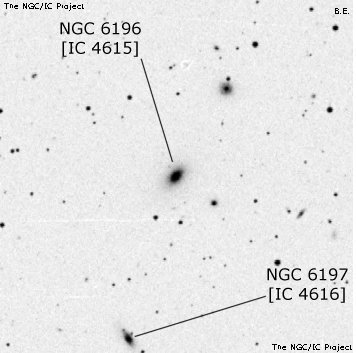NGC/IC Project Restoration Effort
(This is a very very beta version)
NGC6196


Basic Information
Location and Magnitude
Right Ascension: 16:37:53.8
Declination: +36:4:23
Constellation: HER
Visual Magnitude: 12.9
Historic Information
Discoverer: Marth
Year of discovery: 1864
Discovery aperture: 48.0
Observational
Summary description: vF, vS, stellar
Sub-type: E-S0
Corwin's Notes
=====
NGC 6196 = IC 4615, NGC 6197 = IC 4616, and NGC 6199. N6196 is the second
brightest of a small group of galaxies headed up by NGC 6194 (discovered by
John Herschel). Marth's discovery positions for N6196 and N6197 are 38
seconds of time preceding and 1.3 arcmin north of the true positions.
If this same offset applies to NGC 6199, then one of the two stars near the
resulting position is likely the object that Marth saw. Though I pointed to
the brighter of the two during preparation of RC2 as N6199, it has m = 12.0 in
GSC which would almost surely make it unmistakeably a star in Laselle's
48-inch telescope. Thus, I now feel N6199 is more likely to be the fainter
(m = 14.8 in GSC), though the position is further off (about 30 arcsec,
compared to about 15 arcsec) from Marth's (corrected) position.
Where did the IC objects come from? During his survey of the NGC nebulae,
Bigourdan of course could not locate either N6196 or N6197 at their catalogued
positions -- his estimated positions given under these numbers refer to stars.
However, he did find five other nebulae in the area (B209, B324, B325, B425
and B426), and made micrometric observations of the three brightest of these.
It is clear, even in Bigourdan's own notes, that B209 (the brightest) is NGC
6194, though he somehow got the position (from Schultz) incorrect (his
position and Schultz's original position agree to within 10 arcsec).
The other two measured nebulae have, as mentioned above, identical offsets
from Marth's positions, so it is also clear that B325 = IC 4615 = NGC 6196,
and B426 = IC 4616 = NGC 6197. Bigourdan searched in vain, however, for NGC
6199 at Marth's position. It's a bit surprising that he did not make the
connection between the two brighter galaxies and his own, and thus search near
the offset for N6199.
Two other "nebulae" in Bigourdan's group had only estimated positions by
him: B324 = IC 4614, and B425 = IC 4613. IC 4614 is a galaxy, but there is
nothing near his position for IC 4613. See that number for further discussion
of this group.
Steve's Notes
=====
NGC 6196
18" (6/7/08): middle and brightest of three on a line. At 260x it appeared fairly faint, fairly small, slightly elongated, sharply concentrated with a bright, 20" core that increases to a stellar nucleus with direct vision and a 35"x25" halo. IC 4614 lies 3' NNW and NGC 6197 is 5' SSE.
17.5" (6/6/86): brightest in the NGC 6196 group. Fairly faint, small, slightly elongated NW-SE, bright core, fairly faint stellar nucleus. A pair of mag 15 stars are 1.3' S and 1.3' SSE. NGC 6196 is the middle of a linear trio with IC 4614 3.0' NNW and NGC 6197 = IC 4616 4.8' SSE. An extremely faint galaxy (2MASX J16374842+3603393) lies 1.3' SW.
13.1" (8/5/83): fairly faint, bright core.
13.1" (7/5/83): faint, small, round, small bright core. Brightest in group located 45' W and 24' S of M13!



